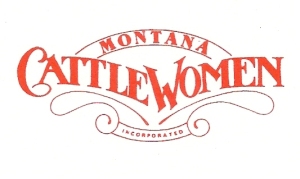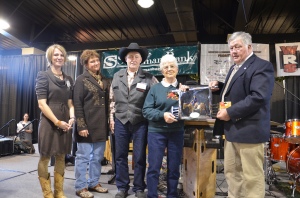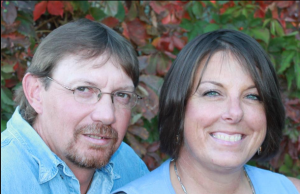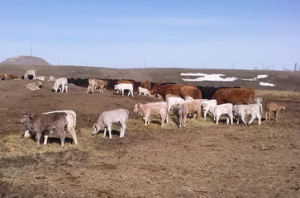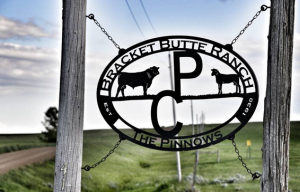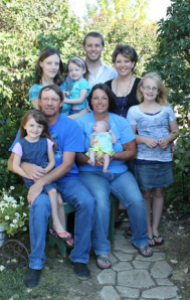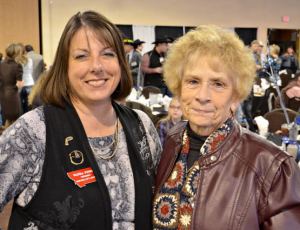 Each year, Montana Stockgrowers recognizes someone who has made great contributions to the ranching community and goes above and beyond to help family and friends. This Ranching Woman of the Year award is a great opportunity to honor the women who are often the backbone of Montana’s ranching communities. These women often go well beyond what is asked of them to support their immediate family members and pitch in whenever the need arises in their communities. This year’s honor recipient is no exception.
Each year, Montana Stockgrowers recognizes someone who has made great contributions to the ranching community and goes above and beyond to help family and friends. This Ranching Woman of the Year award is a great opportunity to honor the women who are often the backbone of Montana’s ranching communities. These women often go well beyond what is asked of them to support their immediate family members and pitch in whenever the need arises in their communities. This year’s honor recipient is no exception.
Bev Fryer, of White Sulphur Springs was recognized as Ranching Woman of the Year during Montana Stockgrowers’ 130th Annual Convention in December. Bev and husband Ed operate the Castle Mountain Ranch, where Bev pitches in on almost every task from long nights of calving heifers, breaking young colts, coordinating annual elk hunts, and making sure everyone is well fed when events bring crowds to visit the ranch.
As her brother, Tim, wrote, Bev is truly a ranch woman who exemplifies the personal family and community attributes of Ranching Woman of the year. Her involvement and commitment to agriculture, love for family and animals began at an early age, and her positive contributions to Montana agriculture have continued ever since as she and husband, Ed, have been operating large cattle ranches for the past forty years.
Early Life and Marriage
 Bev grew up on a family farm in Fishtail, Montana with her parents, Jake and Agnes Schaff, and six siblings. There was plenty of work to go around, milking dairy cows, feeding pigs, along with taking care of cattle, horses, sheep and the families hay ground and custom farming operation. This work surely instilled a strong work ethic for Bev, her brothers and sisters at an early age.
Bev grew up on a family farm in Fishtail, Montana with her parents, Jake and Agnes Schaff, and six siblings. There was plenty of work to go around, milking dairy cows, feeding pigs, along with taking care of cattle, horses, sheep and the families hay ground and custom farming operation. This work surely instilled a strong work ethic for Bev, her brothers and sisters at an early age.
Bev received a bachelor’s degree in elementary education from Montana State University. Through her college career, Bev continued a heavy work schedule, as if it was not a job, but rather a way of life. Afterward, she committed to teaching grade school in a rural community until she realized her time and efforts were more important to her family and helping on the ranch.
Ed and Bev married in June of 1973, while he was working as a cowboy on the Flying D ranch. Bev worked at a laundry and helped around the ranch. They spent several weeks in a tent camp, pushing cattle near the forest boundary, packing salt and sawing trails. From the very start, Bev was heavily involved in calving season, sorting pairs, feeding calves, and any other chores that needed to be done. She pitched in on brandings too and even became a good roper.
Through the late seventies, the couple worked on ranches in the region. Bev became heavily involved in large-scale AI projects, tasked with heat detection, pitching in for every task on the ranch and taught children at rural schools.
Starting a Family
 As their two boys came along, Bev brought them along for the ride, rather than letting them slow her down. Last year’s Ranching Woman of the Year recipient, Glenna Stucky, is a longtime friend of the Fryers, having known Bev and Ed since they worked at the Flying D in the early seventies. One story Glenna loves about Bev shares her dedication to ranch work.
As their two boys came along, Bev brought them along for the ride, rather than letting them slow her down. Last year’s Ranching Woman of the Year recipient, Glenna Stucky, is a longtime friend of the Fryers, having known Bev and Ed since they worked at the Flying D in the early seventies. One story Glenna loves about Bev shares her dedication to ranch work.
“When Bev was pregnant with one of the boys, they lived at the Home Ranch, which was probably five miles and several wire gates from a county road on the way to Bozeman. As one of the boys was about to arrive, Ed was driving Bev to town. When they came to a gate, he would ask, “Bev, are you having a contraction – can you get the gate?” And she always managed to get the gates!” Talk about patience and dedication!
Bev continued being a crucial part of operating ranches where she and Ed worked in Montana and Wyoming. Not only did she hone her skills in the calving shed, Bev also worked to develop early individual identification systems to track individual animals, managed the budgets, payroll and accounting for multiple ranches, and grew large gardens that fed entire working crews on the ranches.
As their boys, Jim and David, grew up, Bev made sure they were involved in ranch work and several 4-H activities. The family took several market steers and horses to the county and state fairs, competed in shooting sports, and worked in many community events.
Move to Castle Mountain
 In 1998, Ed and Bev moved to White Sulphur Springs to the Castle Mountain Ranch, where Bev continued her heavy involvement in operations of the ranch. Over the past 17 years, Bev has been the main calver for the ranch, watching over 300 heifers each year, assisting any new mothers or calves who need help to get a good start, and riding through the mature cows several times a day until turned out to a larger pasture.
In 1998, Ed and Bev moved to White Sulphur Springs to the Castle Mountain Ranch, where Bev continued her heavy involvement in operations of the ranch. Over the past 17 years, Bev has been the main calver for the ranch, watching over 300 heifers each year, assisting any new mothers or calves who need help to get a good start, and riding through the mature cows several times a day until turned out to a larger pasture.
No starving, weak calf is too hopeless for her to nurse back to health. Bev will send the newborns and their mothers off, but only after confirming a good match with plenty of milk. She always tells the men she expects to see the calf doing well at branding. They know she will recognize them, with or without their tags.
Bev breaks all the baby colts on the ranch to lead and stand tied in the barn. The guys may have to rope a honky one for her once in a while, but most of them she gets by herself. Almost all of the Castle Mountain horses have had the benefit of Bev’s first winter’s training and grain.
At Castle Mountain Ranch, Bev manages a special cow elk hunt, developed to disburse and reduce a local concentration of elk. She takes all reservations on a single day for around 150 hunters to spread over the entire season. Bev meets ten or twelve of those hunters at the ranch office an hour before sunrise every day during the season, collects their personal and vehicle identification, conducts a short orientation, assigns maps and hunting areas, and doles out a few tips along the way. Most hunters are amazed at her detailed knowledge of both the country and elk. Most hunters have success, with 50-75% of them getting elk exactly where Bev says they will be.
Taking Care of Friends and Community
 According to her husband Ed, one of the things Bev always does well is cook for large groups of guests and ranch crews with few supplies and hardly an extra trip to town. She may be short an ingredient, but it never seems to matter much as everyone will be fed. Ed describes one such event:
According to her husband Ed, one of the things Bev always does well is cook for large groups of guests and ranch crews with few supplies and hardly an extra trip to town. She may be short an ingredient, but it never seems to matter much as everyone will be fed. Ed describes one such event:
“Years ago, after dark one night before a big shipping, Bev discovered I had no lunch plans for the crew the next day, in an area 50 miles out from any kind of services. With a bit of bustling around, Bev had hot stew and coffee for a dozen of us, plus 25 truckers. All this was prepared on a camp stove, while she helped weigh cattle on what turned out to be a very squally day.”
For several years, Bev has hosted prime rib Christmas parties for 25 people at a time, and served up lunches for the crew at brandings, while pitching in herself, and feeding a family of growing boys and all the challenges ranch life may bring.
Through the years, Bev has been heavily involved in the local and state CattleWomen organizations. In White Sulphur Springs, she leads a group feeding two-day breakfasts for over 1,000 attendees of the annual Red Ants Pants music festival. However, Bev’s love for sharing food, beef in particular, does not stop at the kitchen. She has worked through the CattleWomen to participate in several beef education programs and has served terms as local and state President. She has participated in the National Beef Cook-off several years and works hard to help others learn the importance of beef as part of a healthy diet.
Somehow, Bev also finds time to participate in several community events, including several local ranch rodeo teams through the years. Putting those ranch skills to good use, Bev has contributed to winning teams and helps to host a local ranch rodeo for the past several years.
Importance of Family
 Family is incredibly important to Bev, as she has raised her two sons, and now enjoys taking care of five grandchildren. Both her sons were raised as a big part of the ranches where the family worked, and each now works on cattle operations in Montana. Bev makes sure to nurture her extended family with equal energy.
Family is incredibly important to Bev, as she has raised her two sons, and now enjoys taking care of five grandchildren. Both her sons were raised as a big part of the ranches where the family worked, and each now works on cattle operations in Montana. Bev makes sure to nurture her extended family with equal energy.
Jim’s wife, Heather, remembers wondering when she first met Bev, “Where does all this energy come from?” and now, Heather says she’s never met a harder working woman. Bev asked Heather to help on a three-day project once and they worked every day, non-stop. At the end, Heather was exhausted, but Bev, on the other hand, was fine and even wanted to go to the Hot Springs for a soak at the end of the day.
Bev continually supports her family as Ed’s right hand man for more than 40 years of working together. She has helped her family through several projects, adventures, long-distance moves, and several newborn babies. Bev’s mother is 93 years old and still lives alone. Bev frequently makes the trip to Fishtail to help her mother to doctor appointments, with spring and fall cleaning, and the occasional exploration trip.
Bev Fryer is described time and again by family and friends as a true example of a woman who is the backbone of the ranching operation and her family, a true positive role model in her communities and a complete inspiration to be around. As a woman who exemplifies all the characteristics of a person who makes a truly positive contribution to ranching, Montana Stockgrowers is proud to recognize Bev Fryer as this year’s Ranching Woman of the Year recipient.
To nominate a role model in your life for next year’s Ranching Woman of the Year award, contact the Montana Stockgrowers Association in Helena at (406) 442-3420 or email [email protected]. The nomination process will begin in September 2015.
 The 2015 Montana Cattlewomen’s Memorial Scholarship has been awarded to Lilly Brogger, a senior at Montana State University, Bozeman. Lilly is majoring in English Writing with a minor in Agricultural Business. She has already aligned herself on her career path by writing agriculture-related articles for the school newspaper, The MSU Exponent. Lilly’s plan is to become a Professional Agricultural Journalist.
The 2015 Montana Cattlewomen’s Memorial Scholarship has been awarded to Lilly Brogger, a senior at Montana State University, Bozeman. Lilly is majoring in English Writing with a minor in Agricultural Business. She has already aligned herself on her career path by writing agriculture-related articles for the school newspaper, The MSU Exponent. Lilly’s plan is to become a Professional Agricultural Journalist.
 By Lynda Grande-Myers, Columbus, Montana CattleWomen President
By Lynda Grande-Myers, Columbus, Montana CattleWomen President
 Each year, Montana Stockgrowers recognizes someone who has made great contributions to the ranching community and goes above and beyond to help family and friends. This Ranching Woman of the Year award is a great opportunity to honor the women who are often the backbone of Montana’s ranching communities. These women often go well beyond what is asked of them to support their immediate family members and pitch in whenever the need arises in their communities. This year’s honor recipient is no exception.
Each year, Montana Stockgrowers recognizes someone who has made great contributions to the ranching community and goes above and beyond to help family and friends. This Ranching Woman of the Year award is a great opportunity to honor the women who are often the backbone of Montana’s ranching communities. These women often go well beyond what is asked of them to support their immediate family members and pitch in whenever the need arises in their communities. This year’s honor recipient is no exception. Bev grew up on a family farm in Fishtail, Montana with her parents, Jake and Agnes Schaff, and six siblings. There was plenty of work to go around, milking dairy cows, feeding pigs, along with taking care of cattle, horses, sheep and the families hay ground and custom farming operation. This work surely instilled a strong work ethic for Bev, her brothers and sisters at an early age.
Bev grew up on a family farm in Fishtail, Montana with her parents, Jake and Agnes Schaff, and six siblings. There was plenty of work to go around, milking dairy cows, feeding pigs, along with taking care of cattle, horses, sheep and the families hay ground and custom farming operation. This work surely instilled a strong work ethic for Bev, her brothers and sisters at an early age. As their two boys came along, Bev brought them along for the ride, rather than letting them slow her down. Last year’s Ranching Woman of the Year recipient, Glenna Stucky, is a longtime friend of the Fryers, having known Bev and Ed since they worked at the Flying D in the early seventies. One story Glenna loves about Bev shares her dedication to ranch work.
As their two boys came along, Bev brought them along for the ride, rather than letting them slow her down. Last year’s Ranching Woman of the Year recipient, Glenna Stucky, is a longtime friend of the Fryers, having known Bev and Ed since they worked at the Flying D in the early seventies. One story Glenna loves about Bev shares her dedication to ranch work. In 1998, Ed and Bev moved to White Sulphur Springs to the Castle Mountain Ranch, where Bev continued her heavy involvement in operations of the ranch. Over the past 17 years, Bev has been the main calver for the ranch, watching over 300 heifers each year, assisting any new mothers or calves who need help to get a good start, and riding through the mature cows several times a day until turned out to a larger pasture.
In 1998, Ed and Bev moved to White Sulphur Springs to the Castle Mountain Ranch, where Bev continued her heavy involvement in operations of the ranch. Over the past 17 years, Bev has been the main calver for the ranch, watching over 300 heifers each year, assisting any new mothers or calves who need help to get a good start, and riding through the mature cows several times a day until turned out to a larger pasture. According to her husband Ed, one of the things Bev always does well is cook for large groups of guests and ranch crews with few supplies and hardly an extra trip to town. She may be short an ingredient, but it never seems to matter much as everyone will be fed. Ed describes one such event:
According to her husband Ed, one of the things Bev always does well is cook for large groups of guests and ranch crews with few supplies and hardly an extra trip to town. She may be short an ingredient, but it never seems to matter much as everyone will be fed. Ed describes one such event: Family is incredibly important to Bev, as she has raised her two sons, and now enjoys taking care of five grandchildren. Both her sons were raised as a big part of the ranches where the family worked, and each now works on cattle operations in Montana. Bev makes sure to nurture her extended family with equal energy.
Family is incredibly important to Bev, as she has raised her two sons, and now enjoys taking care of five grandchildren. Both her sons were raised as a big part of the ranches where the family worked, and each now works on cattle operations in Montana. Bev makes sure to nurture her extended family with equal energy.





